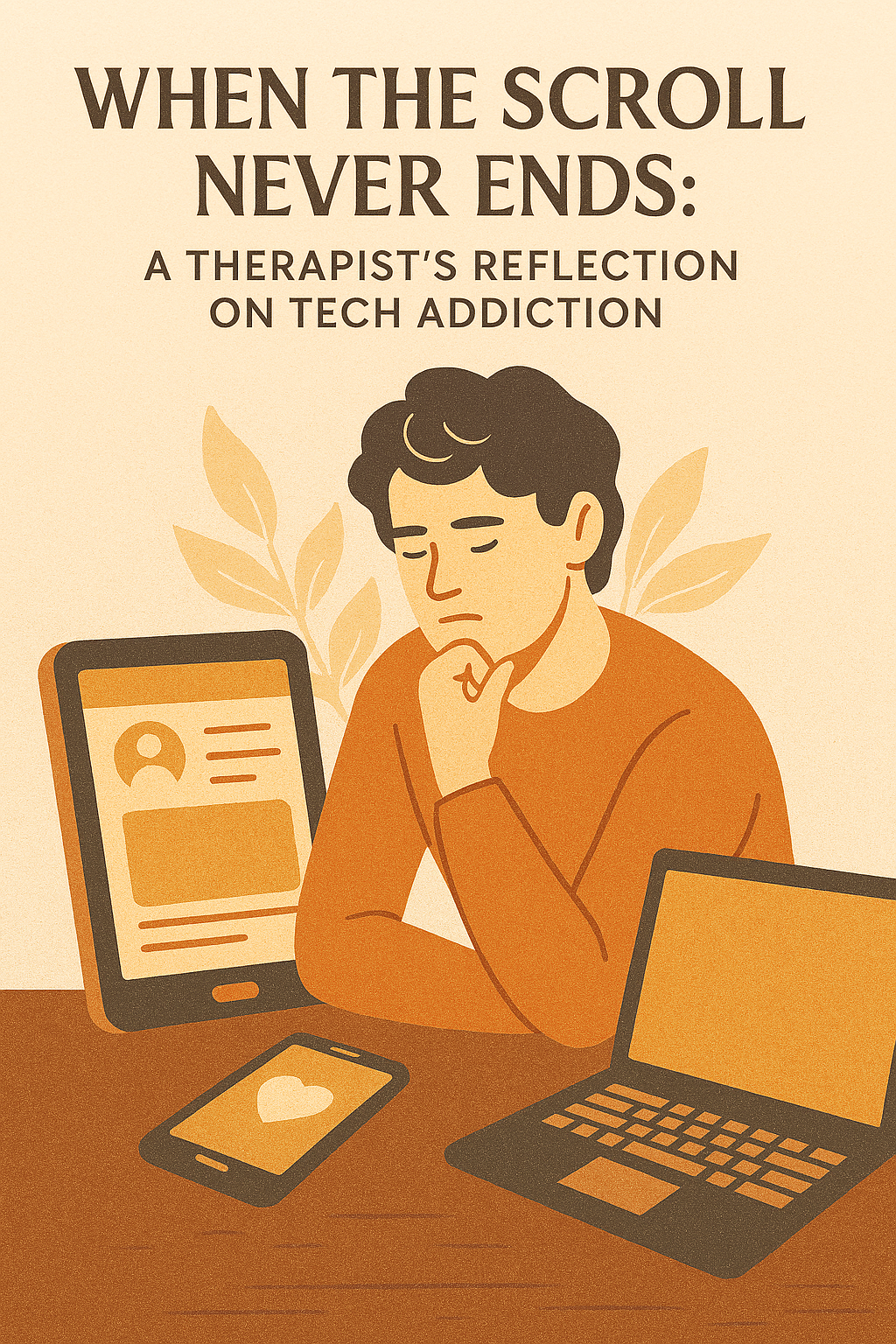When the Scroll Never Ends: A Therapist’s Reflection on Tech Addiction
We’ve all felt it—that quiet tug to check our phones, even when nothing’s waiting for us. The scroll becomes a rhythm, a reflex, a ritual. And slowly, without noticing, we begin to trade moments of presence for pixels of distraction.
Tech addiction doesn’t always look dramatic. It’s subtle. It’s the dinner table where no one speaks. The morning that begins with notifications instead of prayer. The ache of comparison after a few minutes on social media. It’s the way silence feels unbearable, and boredom feels like failure.
Beneath the surface, something deeper is happening. We’re losing touch with the slower parts of ourselves—the parts that need time to think, to feel, to rest. We’re forgetting how to be alone without being lonely. And in that forgetting, we risk losing the very things that make life rich: attention, wonder, relationship, and meaning.
This isn’t a call to abandon technology. It’s a call to reorient. To ask what we’re reaching for when we reach for our phones. To notice what we’re missing when we’re always online. To remember that the most important things in life—love, truth, beauty—don’t come with push notifications.
Healing from tech overuse isn’t just about limits. It’s about longing. It’s about rediscovering what it feels like to be fully present in a moment, to listen without distraction, to create without comparison. It’s about choosing depth over dopamine. And maybe, just maybe, it’s about reclaiming the sacredness of being human in a world that constantly tries to digitize our souls.
The Pitfalls of Tech Addiction
Tech addiction isn’t just about screen time—it’s about what the screen replaces.
• Emotional Avoidance: Many clients use technology to numb anxiety, loneliness, or grief. Social media becomes a balm for rejection; gaming, a refuge from failure.
• Disrupted Attachment: Relationships suffer when digital connection replaces embodied presence. Couples report feeling “alone together,” and children grow up competing with devices for attention.
• Identity Fragmentation: The curated self online can fracture our sense of authenticity. We begin to measure worth by likes, followers, or productivity apps, losing touch with who we are offline.
• Neurochemical Hijacking: Dopamine loops—triggered by notifications, novelty, and reward—train the brain to crave stimulation, making silence and stillness feel intolerable.
Therapy Solutions: Reclaiming the Self
Healing from tech addiction isn’t about demonizing devices—it’s about restoring agency, connection, and meaning.
1. Digital Boundaries with Compassion
We start by mapping usage patterns: when, why, and how tech shows up. Then we co-create boundaries—not as punishment, but as protection. Timers, app limits, and screen-free zones become acts of self-respect.
2. Somatic Grounding
Tech addiction often disconnects us from the body. I guide clients through breathwork, movement, and sensory rituals to re-anchor in the present moment. The body becomes a safe place again.
3. Narrative Therapy
We explore the stories behind the scroll. What does the phone offer that life doesn’t? What fears arise in silence? By naming these truths, clients begin to rewrite their relationship with technology.
4. Values-Based Living
I help clients identify core values—faith, creativity, service, rest—and build daily rhythms that honor them. Tech becomes a tool, not a tyrant.
5. Spiritual Integration
For clients of faith, we explore how tech addiction impacts prayer, presence, and vocation. Silence is reframed not as emptiness, but as sacred space. We practice digital sabbath, not just as detox, but as devotion.
A Final Word
Tech addiction is not a moral failure—it’s a symptom of deeper hunger. In therapy, we don’t just unplug; we listen. We ask what the soul is truly craving. And slowly, we begin to reclaim the life that was never meant to be lived through a screen.


